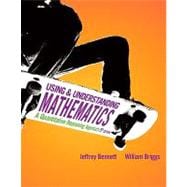Using and Understanding Mathematics: A Quantitative Reasoning Approach increases students' mathematical literacy so that they better understand the mathematics used in their daily lives.
Ideal for courses that emphasize quantitative reasoning, Bennett and Briggs prepare students to use math effectively to make better decisions throughout their lives. Contents are organized with that in mind, with engaging coverage in sections like Taking Control of Your Finances, Dividing the Political Pie, and a full chapter about Mathematics and the Arts.
This Fifth Edition offers new hands-on Activities for use with students in class, new ways for students to check their understanding through Quick Quizzes, and a new question type in MyMathLab that applies math to recent events in the news. In addition, the authors increase their coverage of consumer math, and provide a stronger emphasis on technology through new Using Technology features and exercises. The new Insider's Guide provides instructors with tips and ideas for effective use of the text in teaching the course.
The real-world focus turns students’ attention to the math they will need for their daily lives, and keeps them engaged during the course. A wide range of exercises and problem types end each unit, making it easy for instructors to create assignments to fit their course goals.









